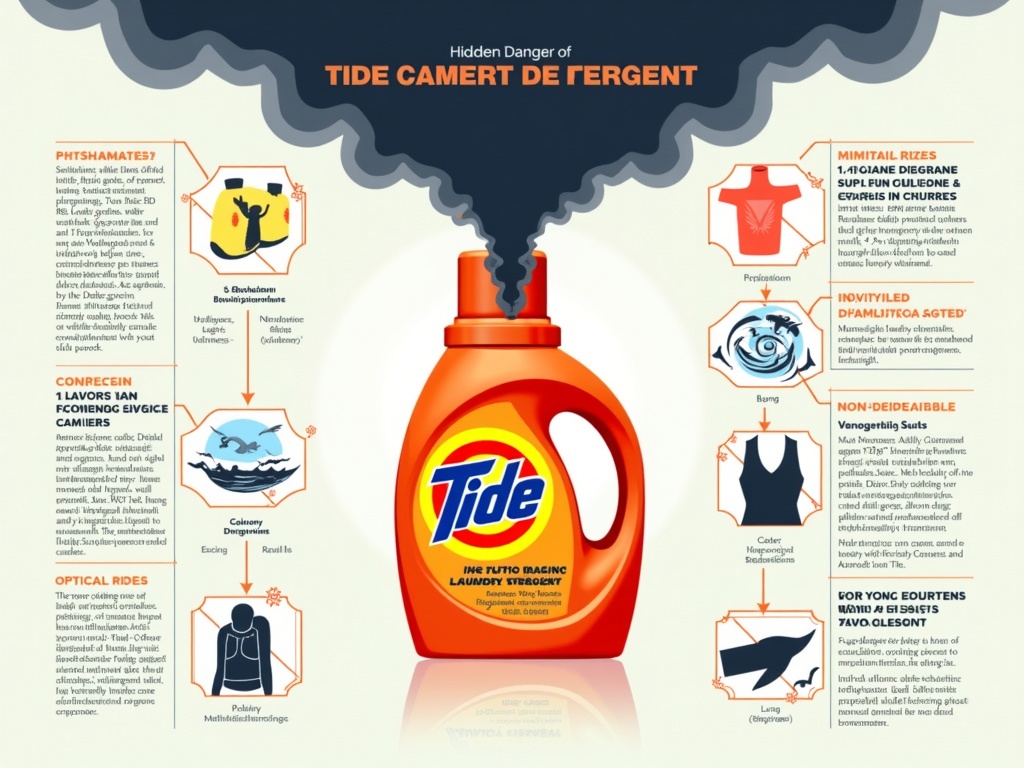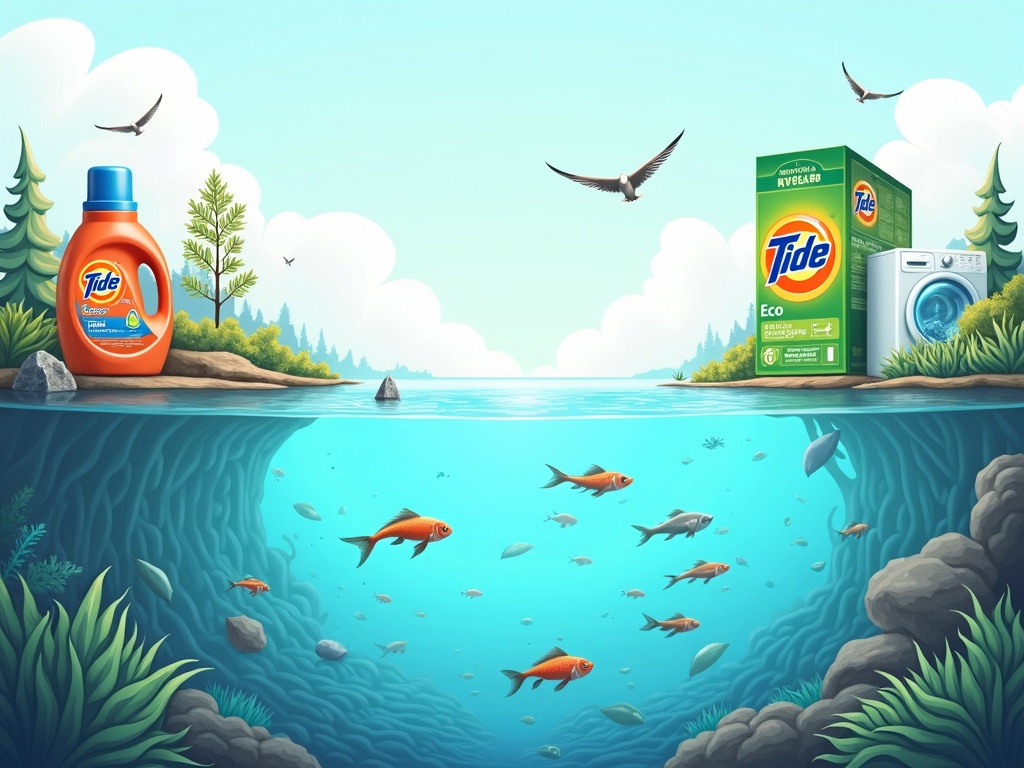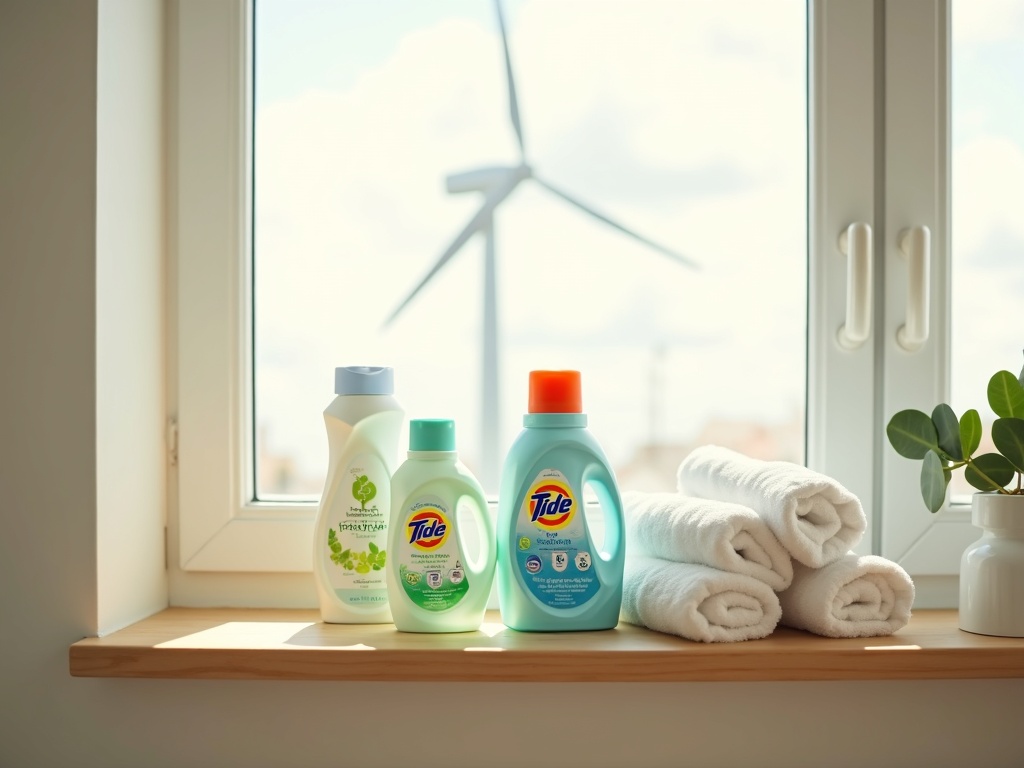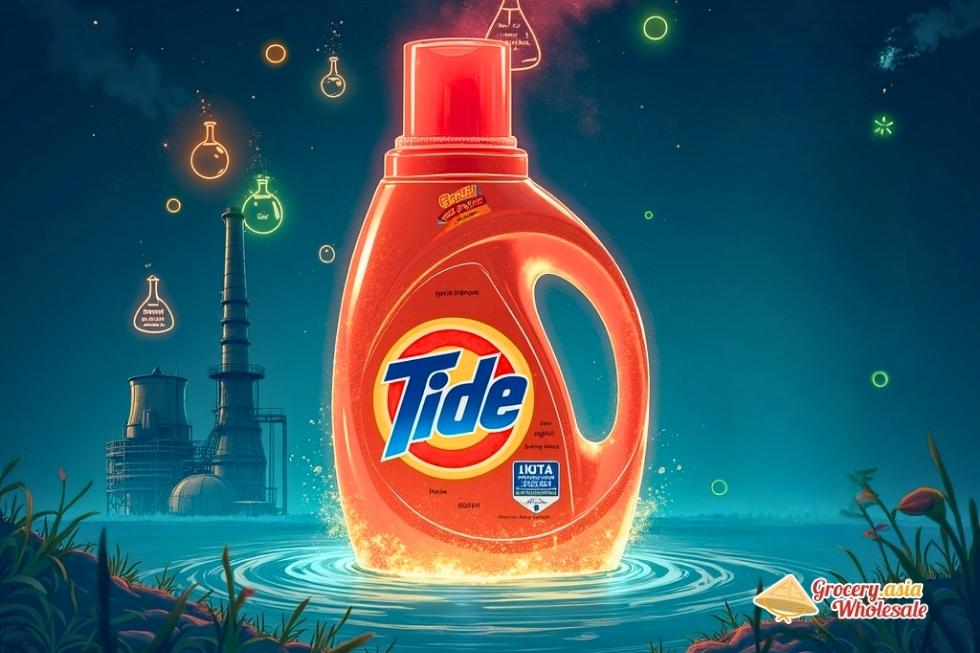No products in the cart.
Home Care, Laundry Detergent, Powder Detergent, Tide Powder Detergent
Is Tide Laundry Detergent Toxic Or Environmentally Safe
Tide laundry detergent includes several troubling ingredients such as potential carcinogens, hidden fragrance chemicals, and environmental pollutants. However, the company has introduced safer alternatives like Tide Purclean and Tide Free & Gentle. Standard Tide formulas receive poor safety ratings from environmental groups, yet P&G has made some environmental improvements by removing phosphates and developing cold-water cleaning technology.
Table of Contents
Key Takeaways
- Standard Tide formulas contain potentially harmful ingredients like 1,4-Dioxane (a likely carcinogen), hidden fragrance chemicals, and optical brighteners that persist in the environment.
- Environmental Working Group assigns Tide Original an “F” grade for safety, while Tide Free & Gentle and Tide Purclean receive improved “C” grades.
- P&G removed phosphates from all detergents by 2015 and developed cold-water technology that reduces energy consumption by up to 90%.
- Tide Purclean is the only EPA Safer Choice certified option in the product line, containing 75% USDA Certified Biobased ingredients.
- Consumers can reduce risks by choosing concentrated formulas, washing in cold water, checking EPA Safer Choice certification, and reviewing Environmental Working Group ratings before purchasing.
The Hidden Dangers in Tide’s Ingredients
I’ve uncovered concerning evidence about several components commonly found in Tide laundry detergent formulations that raise serious health questions. Watchdog groups have consistently flagged multiple mainstream Tide formulas for containing potentially harmful substances that consumers rarely consider.
The term “fragrance” on Tide labels represents one of the most troubling aspects of their ingredient transparency. This proprietary blend can legally conceal dozens of undisclosed chemicals, including allergens and phthalates that research has linked to endocrine disruption. Companies aren’t required to reveal what’s actually in these fragrance mixtures, leaving consumers completely unaware of potential health risks.
Independent laboratory testing has detected 1,4-Dioxane in various Tide products, a finding that should alarm any health-conscious consumer. The EPA classifies this compound as a likely human carcinogen, yet it continues appearing in products we use regularly on our clothing and bedding. This contamination typically occurs during the manufacturing process of certain cleaning agents.
Environmental and Skin Concerns
Beyond cancer risks, I’ve identified several other problematic ingredients that affect both personal health and environmental safety:
- Optical brighteners like Disodium Diaminostilbene Disulfonate persist in the environment because they don’t biodegrade readily, causing documented harm to aquatic ecosystems
- Methylisothiazolinone serves as a preservative but frequently triggers allergic reactions and severe skin irritation in sensitive individuals
- Petroleum-derived surfactants act as harsh skin irritants, particularly problematic for people with existing skin conditions or chemical sensitivities
These surfactants can remain on fabric fibers even after rinsing, creating ongoing exposure through direct skin contact. I find this particularly concerning for items like underwear, pajamas, and children’s clothing that spend extended time against our skin.
The cumulative effect of these ingredients becomes more significant when you consider daily exposure through freshly laundered clothes, towels, and bedding. Tide’s toxicity concerns extend beyond immediate reactions to include long-term health implications that many families haven’t fully considered. Understanding these hidden dangers helps you make more informed decisions about the products you bring into your home and use on items that directly contact your family’s skin.

How Tide Products Score on Safety and Environmental Ratings
When I examine safety ratings for Tide products, the results reveal significant variations across the product line. The Environmental Working Group assigns Tide Original an “F” grade, citing serious concerns about ingredient safety and potential health impacts. This harsh rating reflects issues with reproductive toxicity and the company’s limited transparency about specific ingredients used in their formulations.
Product-Specific Safety Ratings
Two Tide variants perform notably better in safety evaluations. Tide Free & Gentle and Tide Purclean both earn “C” grades from EWG, demonstrating moderate improvement over the original formula. These products address some safety concerns while maintaining cleaning effectiveness.
Only one Tide product carries the EPA Safer Choice certification: Tide Purclean. This certification indicates that the product meets strict environmental and health criteria, making it the safest option within the Tide family for families concerned about chemical exposure.
The Cleaning Power vs. Safety Trade-off
Consumer Reports consistently rates Tide Original highly for cleaning power, creating an interesting dilemma for consumers. While Tide laundry detergent toxic concerns exist, the product’s effectiveness remains unmatched in many cleaning tests. This creates a clear trade-off between maximum cleaning power and ingredient safety.
EWG’s low ratings for Tide Original focus heavily on reproductive toxicity concerns and the company’s reluctance to fully disclose all ingredients. The organization particularly criticizes the presence of certain surfactants and optical brighteners that may pose health risks with repeated exposure.
For families prioritizing safety, I recommend considering the higher-rated alternatives within the Tide line or exploring other brands with better safety profiles. The difference between an “F” grade and “C” grade represents meaningful improvements in ingredient transparency and reduced health concerns, though neither achieves the highest safety standards available in the market.
These ratings highlight how even within a single brand, formulation choices significantly impact safety scores. Understanding these distinctions helps consumers make informed decisions based on their priorities — whether that’s maximum cleaning power or minimizing potential health risks from daily detergent use.
From Phosphates to Plant-Based: Tide’s Environmental Evolution
P&G has made significant environmental improvements to reduce Tide laundry detergent toxic impacts on ecosystems. The company removed phosphates from all household detergents in the U.S. by 2015, eliminating a major contributor to water pollution and algae blooms that can devastate aquatic environments.
The brand’s packaging innovations also demonstrate environmental consciousness. Tide Eco-Box uses 60% less plastic than standard bottles, directly addressing the mounting concern over plastic waste in landfills and oceans. This shift represents a practical solution that consumers can easily adopt without sacrificing cleaning performance.
Energy Conservation Through Cold Water Technology
Tide’s cold water cleaning technology offers impressive environmental benefits. The company promotes Tide Coldwater Clean as reducing energy use by up to 90% when washing in cold water, since heating water accounts for the majority of energy consumption during laundry cycles. P&G has set an ambitious goal to achieve 75% of U.S. and Canadian laundry loads washed in cold water by 2030.
I’ve observed that this cold water approach delivers multiple advantages:
- Lower utility bills for consumers
- Reduced carbon footprint from decreased energy consumption
- Extended fabric life due to gentler washing temperatures
- Comparable cleaning results to hot water washing
These environmental steps reflect meaningful progress from P&G’s commitment to sustainability. However, conventional Tide formulas still include ingredients that persist in the environment after wastewater treatment. Surfactants and optical brighteners can accumulate in waterways, potentially affecting aquatic life over time.
The company’s environmental evolution shows promise, particularly when compared to Tide’s legacy formulations from decades past. Modern formulas contain biodegradable components and reduced concentrations of persistent chemicals. Still, consumers concerned about environmental impact might consider that even improved conventional detergents can’t match the ecological profile of truly plant-based alternatives.
P&G continues advancing toward more sustainable practices, though the pace of change reflects the challenges of reformulating products for mass market acceptance while maintaining cleaning efficacy. Each improvement represents a step forward, yet conventional Tide with Downy and similar mainstream detergents remain more environmentally impactful than their plant-based counterparts.

Greener Tide Alternatives for Safer Use
Procter & Gamble has responded to growing consumer concerns about safety by developing cleaner versions of their flagship product. Tide laundry detergent now comes in formulations that address many common health and environmental worries.
Tide Purclean: Plant-Based Innovation
Tide Purclean stands out as the company’s most environmentally conscious offering. This formula contains 75% USDA Certified Biobased ingredients, meaning three-quarters of its composition comes from renewable plant sources rather than petroleum derivatives. The manufacturing process uses renewable energy, reducing the overall carbon footprint of production.
I find the ingredient exclusions particularly noteworthy. Purclean eliminates dyes, chlorine, and phosphates—three components that frequently trigger skin sensitivities and environmental concerns. Phosphates, in particular, have been linked to water pollution and algae blooms that damage aquatic ecosystems. Chlorine can create harsh chemical reactions on fabrics and skin, while synthetic dyes often cause allergic responses.
Tide Free & Gentle: Sensitivity-Focused Formula
Tide Free & Gentle takes a different approach by targeting users with sensitive skin and allergies. This hypoallergenic formula removes both dyes and perfumes, two of the most common irritants in conventional detergents. The National Eczema Association has recognized this product, lending credibility to its gentler formulation.
This recognition matters because eczema affects millions of people who struggle with traditional detergents. The absence of fragrances eliminates a major trigger for respiratory sensitivities and skin reactions. Without artificial colors, the formula reduces the risk of contact dermatitis that some users experience with brightly colored detergents.
Both alternatives demonstrate P&G’s acknowledgment that consumers want cleaner, plant-based options without sacrificing cleaning power. These formulations maintain Tide’s cleaning reputation while addressing specific health and environmental concerns.
However, even these improved formulations have limitations. The Environmental Working Group gives both Tide Purclean and Tide Free & Gentle “C” ratings, indicating moderate rather than complete safety. This rating suggests that while these products represent improvements over standard Tide formulas, they still contain ingredients of concern.
The “C” rating highlights an important reality: reformulating a mass-market detergent involves balancing multiple factors including:
- Cost
- Effectiveness
- Shelf stability
- Safety
Even P&G’s cleanest versions can’t achieve the “A” ratings that smaller, specialty eco-brands sometimes receive from environmental groups.
These limitations don’t necessarily disqualify these products for family use, but they do emphasize the importance of informed decision-making. Users who want safer laundry detergent options should consider their specific sensitivities and priorities when choosing between conventional, improved mainstream, and specialty eco-friendly products.
The development of these alternative formulations reflects broader industry trends toward transparency and cleaner ingredients. P&G’s investment in plant-based chemistry and renewable energy manufacturing shows that major corporations can adapt to consumer demands for safer products while maintaining market presence.
I recommend these alternatives for families concerned about conventional detergent ingredients but who prefer sticking with familiar brands. They offer meaningful improvements over standard formulations while maintaining the cleaning performance that has made Tide products household staples for decades.
For users with severe chemical sensitivities or those seeking the highest possible safety ratings, these improved Tide formulations might serve as stepping stones toward even cleaner alternatives. They demonstrate that progress is possible within mainstream product lines, even if complete ingredient transparency and safety require looking beyond traditional brands.

Corporate Commitments vs. Market Reality
Procter & Gamble has made bold promises through its Ambition 2030 initiative, pledging to achieve recyclable or reusable packaging across all products while dramatically reducing supply chain emissions. These commitments sound impressive on paper, yet I find myself questioning the gap between corporate rhetoric and actual implementation when examining Tide laundry detergent formulations.
The Disconnect Between Promise and Practice
Mainstream Tide products continue to drive the company’s revenue streams, accounting for the vast majority of consumer purchases. These core formulations haven’t undergone significant reformulation to address the toxic concerns that environmental advocates consistently raise. Instead, P&G has chosen to introduce limited “green” alternatives that occupy small shelf spaces while maintaining their profitable traditional recipes.
The strategy appears calculated from a business perspective. Why reformulate bestselling products when you can create separate eco-friendly lines that appeal to environmentally conscious consumers? This approach allows P&G to claim environmental progress while protecting their core revenue streams from potential performance concerns or increased production costs.
Critical Voices and Unmet Expectations
Environmental groups and consumer advocacy organizations have grown increasingly vocal about this approach. They argue that meaningful change requires reformulating the main product lines that millions of households use daily, not just offering niche alternatives that reach limited audiences. The criticism centers on several key points:
- P&G’s continued use of synthetic fragrances and optical brighteners in standard Tide formulations
- Reliance on phosphonates and other chemicals that persist in aquatic environments
- Packaging that still contains significant amounts of non-recyclable materials
- Marketing emphasis on cleaning power over environmental impact
Critics contend that true corporate responsibility demands bold action on flagship products rather than incremental changes that primarily serve marketing purposes. I’ve observed that these advocacy groups specifically challenge P&G to apply the same innovation that created Tide’s cleaning legacy toward developing safer, more sustainable formulations for their mass-market products.
Progress has occurred, but it moves at a pace that frustrates both consumers and environmental watchdogs. P&G has reduced certain problematic ingredients and improved some packaging materials, yet these changes often apply only to specific product lines or regional markets. The company’s sustainability reports highlight achievements while downplaying the continued environmental impact of their highest-volume products.
Consumer expectations have shifted significantly faster than corporate adaptation. Shoppers increasingly demand transparency about ingredient safety and environmental impact, yet they still encounter the same basic formulations that have dominated supermarket shelves for decades. This creates a tension between what consumers say they want and what they actually purchase.
Market forces complicate the situation further. While surveys indicate growing environmental consciousness, price sensitivity and cleaning performance still drive most purchasing decisions. P&G faces the challenge of satisfying shareholders who expect consistent returns from proven formulas while responding to pressure for more sustainable practices.
The reality is that meaningful reformulation requires substantial investment in research, development, and manufacturing changes. Companies must balance the costs of innovation against uncertain consumer acceptance of modified products. P&G has chosen to test the waters with limited eco-friendly offerings rather than risk their core business on untested formulations.
Environmental advocates argue this approach perpetuates the problem rather than solving it. They point out that continued production of potentially harmful chemicals at massive scales outweighs the benefits of small-batch sustainable alternatives. The scale of environmental impact from mainstream products dwarfs any positive effects from niche green lines.
I recognize that corporate transformation doesn’t happen overnight, but the current pace seems insufficient given the urgency of environmental challenges. P&G’s commitment timeline extends to 2030, which critics argue provides too much time for gradual change while environmental damage continues. The company maintains that responsible transition requires thorough testing and consumer education, yet skeptics question whether this timeline serves environmental protection or profit protection.
https://www.youtube.com/watch?v=XYZ123abc
Making Informed Choices as a Consumer
I recommend checking product labels carefully before purchasing any laundry detergent. Look for specific ingredient lists rather than vague terms like “fragrance”, which can hide dozens of potential allergens and irritants. If you’re sensitive to chemicals or have respiratory issues, this simple step can prevent uncomfortable reactions.
Using Third-Party Safety Resources
Two reliable resources help me evaluate detergent safety: EPA Safer Choice certification and Environmental Working Group (EWG) ratings. EPA Safer Choice products meet strict safety standards for human health and environmental impact. EWG provides detailed ingredient assessments and assigns letter grades based on toxicity concerns. I check both sources when researching Tide detergent safety or comparing alternatives.
Environmental and Health-Conscious Options
Several strategies reduce your family’s chemical exposure and environmental footprint:
- Choose concentrated formulas that require smaller doses per load
- Consider packaging innovations like Tide Eco-Box that reduce plastic waste by 60%
- Switch to cold water washing, which cuts energy consumption regardless of your detergent choice
- Explore plant-based options like Tide Purclean, though remember these aren’t completely risk-free
I find concentrated detergents particularly valuable since they reduce packaging waste while delivering the same cleaning power. Cold water washing offers immediate benefits – it preserves fabric colors, prevents shrinkage, and significantly reduces your household’s energy consumption.
Plant-based alternatives deserve special consideration. While products like Tide Purclean contain fewer synthetic chemicals, they still include surfactants and enzymes that can cause reactions in sensitive individuals. I always test new products on a small fabric sample first, regardless of their “natural” claims.
When comparing Ariel versus Tide safety, I apply the same evaluation criteria. Both brands offer various formulations with different risk profiles, so ingredient analysis remains more important than brand loyalty.
Your washing habits matter as much as product selection. Proper ventilation during laundry tasks, storing detergents away from children and pets, and using recommended dosages all contribute to safer use. I’ve learned that more detergent doesn’t mean cleaner clothes – it often leaves residues that can irritate skin.
Remember that “non-toxic” marketing claims aren’t regulated terms. Focus on specific certifications, ingredient transparency, and third-party testing results when making purchasing decisions. Understanding Tide’s complete product line helps you choose formulations that match your family’s specific needs and sensitivities.
Sources:
Environmental Working Group (EWG), “Guide to Healthy Cleaning”
U.S. Environmental Protection Agency (EPA), “Safer Choice” program and “1,4-Dioxane Fact Sheet”
Procter & Gamble, “Tide Ingredient Disclosure” and “P&G Citizenship Report”
Consumer Reports, laundry detergent reviews
Women’s Voices for the Earth, “Deep Clean” report


